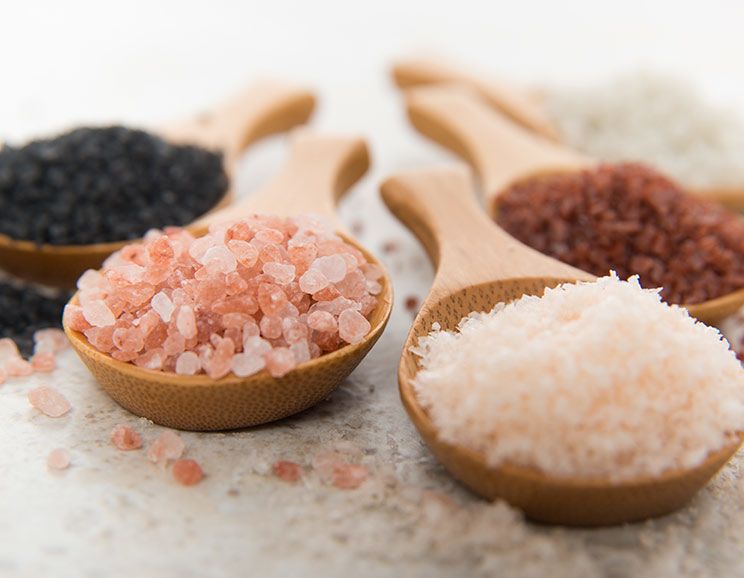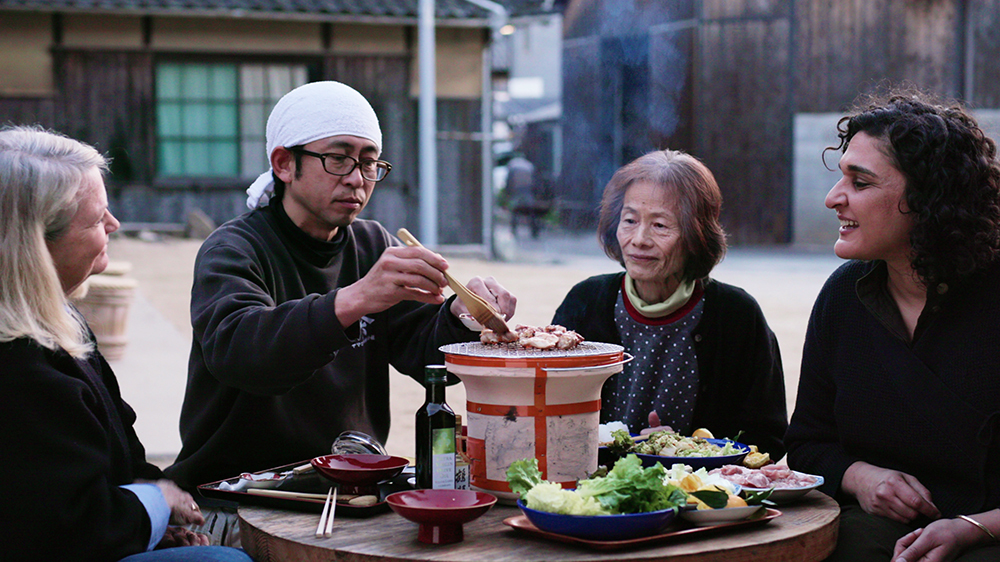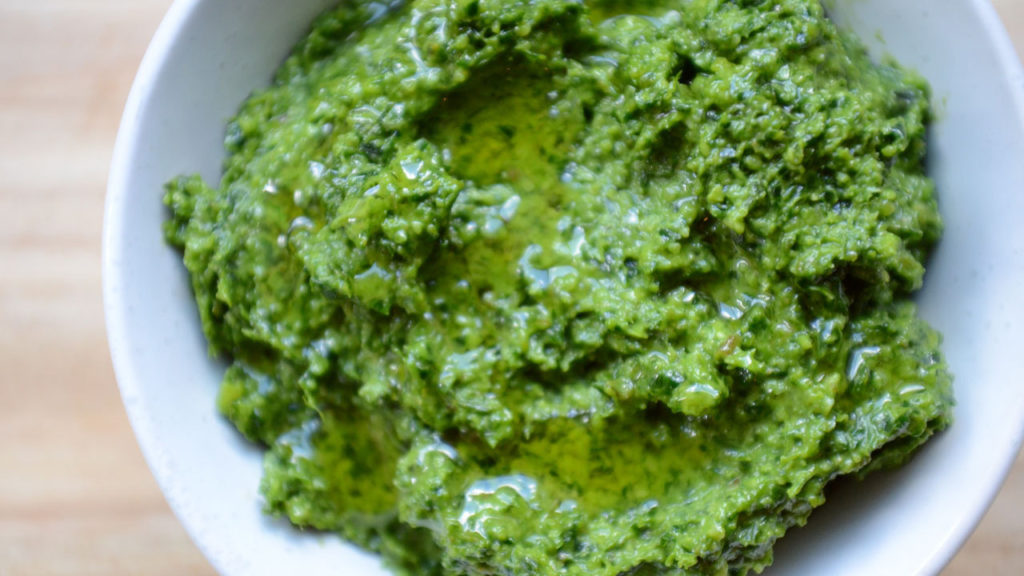
Samin Nosrat (centre) with friends in a scene from the show, Salt, Fat, Acid, Heat. Her mother stands behind her
Salt, Fat, Acid, Heat, a TV show on Netflix hosted by American chef, author and columnist Samin Nosrat, will change your attitude to food. After watching it you will be overwhelmed by the need to leap off your couch … and get cooking. It’s that inspirational. (Don’t miss recipes below)
I love salt. I love sweet/salty combinations, salt sprinkled over fruit, in food naturally, and pops of flavour from flakes of smokey salt, or coarsely-ground Himalayan salt, sprinkled over food after cooking. And who can resist biltong. That true ode to salt. Salt makes just everything taste better. Salt makes the world go round.
And I’m not alone in my passion.
This is what Chef Samin Nosrat, dark-eyed-and-haired, embullient in personality and generous of spirit, says about salt: “Salt enhances flavour, and it has a greater impact on flavor than any other ingredient. Though salt also affects texture and helps modify other flavors, nearly every decision you’ll make about salt will involve amplifying and deepening flavor. Add it in the right amount, at the right time, in the right form, and your food will be delicious.”
Who could have said it better.

Salt in its many glorious forms
But salt has its enemies. The Salt Police, who try to restrict the salt intake of their friends and family members, pointing to “health” warnings. The food producers who proudly proclaim “less salt” on labels fixed to their products, yet who choose to ignore the chemical preservatives they use. But, the most exasperating trend of all is the restaurant chefs who don’t salt food during the cooking process, believing diners should add according to their individual tastes. But here’s thing. You can’t. If you don’t salt food during cooking, you can never, ever add enough afterwards. It never tastes right.
Salt is one of the four esential elements to cooking that Samin Nosrat, who was born to an Iranian family in San Diego, explores in Salt, Fat, Acid, Heat screened by Netflix. It’s based on her multiple, award-winning book of the same name. The show is inspiring every foodie worth his/her salt to start cooking – and talking about food.
In this four-part series, Samin Nosrat travels the world to demystify and explore the essential essences of what makes food delicious. The episodes follows Samin as she visits home kitchens in Italy (fat), the southern islands of Japan (salt), the heat of the Yucatán (acid), and to Berkeley’s legendary restaurant, Chez Panisse, (heat) to explore the four secrets to fabulous food. And what is particularly heart-warming is the tribute the show pays to the much older women, and men, whose passion for traditional foods and cooking is ensuring they’re not lost to younger generations.
Early on in the first episode, Samin promises her viewers: “Just four basic elements can make or break a dish: salt, fat, acid, and heat. Commit to mastering them and you can become not only a good cook, but a great one.”
Is that appealing or not?

In Japan, in a scene from the show, cooking with soy sauce, an additional source of salt
Naturally, the episode on salt was my favourite. In this episode she visits Japan to explore their passion for salty flavours. There are 4,000 different types of salt in Japan, with flavour and level of saltiness determined by the production and size of the grains. Unlike other countries where sea salt is harvested from water alone, the Japanese make their moshio from dried seaweed. In Japan, the seasoning of a dish isn’t only from salt; there are other products such as miso (soybeans fermented with salt) and soy which provide saltiness and umami.
In this episode Nosrat tastes miso that has been aged for three years. She learns how the traditional method for making soy sauce involves century-old wooden barrels, and that it could be a dying art. Industrial soy sauce ferments for three months, but this artisanal variety stays in the barrels for two years. She even visits a salt shop in Tokyo where she learns how to taste salt from a ‘salt sommelier’.
In the episode on fat, Nosrat travels to Italy, where she once studied cooking, to talk about the importance of fat in making food delicious. She visits an olive grove, helps harvest olives and prepares food with olive oil. This episode was so evocative as all I wanted was to be at her side tasting the olive oil. She also visits a producer of Parmigiano-Reggiano, the real deal. Do you know that Parmigiano-Reggiano is produced exclusively in the provinces of Parma, Reggio Emilia, Modena and parts of the provinces of Mantua and Bologna, on the plains, hills and mountains enclosed between the rivers Po and Reno?
Interestingly, the fat in Parmesan cheese is lower than that in cheddar, stilton and mascarpone, and barely higher than brie and paneer.
She says: “Fat is essential for achieving the full spectrum of flavours and textures of good cooking. Simply put, fat carries flavour. Which fats you use primarily affect flavour, but how you use them will determine texture, which is just as important. Varied textures excited our palates, and fat makes five distinct textures possible: Crisp, Creamy, Flaky, Tender, and Light.”

The salty, fatty joys of Parmigiano-Reggiano
Another favourite episode was the one on acid. It focuses on how the the right proportion of acid can amp up flavours. She cooks with sour oranges and limes and other sour foods available on Mexico’s Yucatan peninsula.
She says: “Acid balances flavour. Anything that tastes sour is a source of acid, yet on its own, acid isn’t particularly gratifying. It’s the way acid contrasts with other tastes that heightens our pleasure in foods. Salt, fat, sugar, bitterness and starch all invariably benefit from the welcome contract acid provides.”
To demonstrate heat, she return home to Berkeley to cook a bountiful meal for friends
She says: “Heat is the element of transformation. It triggers the changes that take our food from raw to cooked, runny to set, flabby to firm, flat to risen, and pale to golden brown. At the heart of good cooking lies good decision making, and the primary decision regarding heat is whether to cook food slowly over gentle heat or quickly over intense heat. Learn to use all of your senses—including common sense—to determine which level and source of heat to use.”
If you click onto www.saltfatacidheat.com you find find recipes demonstrated during the show. These two were appealing to me.

Basil pesto
BASIL PESTO
I love this recipe, says Samin, “because it’s so simple, so flavourful and is essentially a brilliant vehicle for my favourite ingredient, Parmesan!”
Technique tips: Heat your serving bowl by using it as a lid for the pasta pot! Add a pinch of salt into the mortar to create friction and help break down the garlic.
Swap options: Instead of a mortar and pestle, pesto can also be made in a food processor or blender. Just do your best not to over-blend the basil because the heat from the motor can cause it to blacken.
Use bucatini, penne, garganelli or casarecce (pastas) instead of trofie or spaghetti.
Ingredients
1/4 cup pine nuts
1 medium clove garlic, peeled
2 cups tightly packed basil leaves
2/3 cup finely grated Parmigiano-Reggiano, plus more for serving
1/3 cup finely grated pecorino
Sea salt
1/3 cup extra-virgin olive oil, plus more as needed
1 pound (425 g) trofie (a short thin, twisted pasta) or spaghetti
Preparation
- Set a large pot of water to boil over high heat.
- Use a mortar and pestle to pound and grind the pine nuts to a fine paste (no distinct pieces should be visible). Add the garlic and pound until smooth and integrated.
- If the basil leaves are very large, run a knife through them once or twice to cut them down in size. Add basil to pine nuts along with a pinch of salt, which will help break down the leaves. Continue pounding and grinding until the basil breaks down completely (if your mortar is small, pound the basil in batches), about 7 minutes. Once the nuts and basil combine into a thick green paste, stir in Parmesan, pecorino, and oil. Taste and adjust salt as needed.
- Generously season water with salt. Cook pasta until al dente, then drain, reserving a cup of cooking water.
- Place cooked pasta in serving bowl and stir in pesto. Add splashes of cooking water and olive oil as needed to loosen the sauce and ensure the pasta is evenly coated. Garnish with Parmigiano and serve immediately.
- Immerse any leftover pesto in olive oil. Cover and refrigerate for up to 2 days.

Persian rice (tahdig). Who can resist buttery, crispy rice?
PERSIAN-ISH RICE/TAHDIG (SCORCHED RICE)
(Although not mentioned in the recipe below, in the TV show Samin cooks this dish with her mother and adds a pinch of crushed saffron for extra flavour. I’ve also seen recipes using a pinch of tumeric for added colour)
2 cups (390 grams) basmati rice
Salt
3 tablespoons plain yogurt
3 tablespoons butter
3 tablespoons neutral-tasting oil
- Place rice in a bowl and rinse with cold water. Swirl vigorously with your fingers to release the starch, and change the water at least five times, until it runs clear. Once the water runs clear, let rice soak for 30 minutes.
- Fill a large stockpot with 4 quarts of water. Cover and bring to a boil over high heat.
- Once the water comes to a boil, salt it heavily. The precise amount will vary depending on what kind of salt you’re using, but it’s about 6 tablespoons fine sea salt or a generous 1⁄2 cup kosher salt. The water should taste saltier than the saltiest seawater you’ve ever tasted. This is your big chance to get the rice seasoned from within, and it’s only going to spend a few minutes in the salted water, so don’t panic about oversalting your food. Drain the rice, then add it to the pot and stir.
- Set a fine-mesh sieve or colander in the sink. Cook rice, stirring occasionally, until al dente, 5 to 7 minutes. Drain into the sieve, then rinse with cold water to keep rice from cooking further. Drain rice well and place in a large bowl.
- Remove 1 heaping cup of the rice to a small bowl and combine it with the yogurt.
- Set a very well seasoned 10-inch cast iron pan or nonstick skillet over medium-high heat. Add butter and the oil. When butter melts, add rice-yogurt mixture and spread it out into a thin, even layer with a heatproof spatula.
- Pile remaining rice into the pan, mounding it gently toward the center. Using the handle of a wooden spoon, gently dig 6 holes into the rice down to the bottom of the pot, which will be barely sizzling. Dig 5 of the holes about 2 inches from the sides of the pan, and put one in the center. (The holes will allow steam to escape from the bottommost layer of rice and allow a crisp crust to form.) There should be enough oil in the pan that you can see it bubbling up the sides; add a little more oil along the edges of the rice if needed to see these bubbles.
- Continue cooking rice over medium-high heat for 8 minutes, or until evenly browned along the edges, rotating the pan a half turn after 4 minutes to ensure even browning. Wrap a lid with a kitchen towel and cover pan. Turn the heat as low as it will go and continue cooking another 45 minutes, rotating the pan a quarter turn every 10 to 12 minutes. The rice is done when it’s cooked completely through.
- To unmold the rice, carefully run an offset spatula or butter knife along the edges of the pan to ensure that no part of the crust is sticking. Tip out any excess fat at the bottom of the pan into a bowl, gather your courage, and then carefully flip it onto a platter or cutting board. Serve immediately.
- And if for any reason your rice doesn’t slip out in one piece, do what every Persian grandmother since the beginning of time has done: scoop out the rice, chip out the tahdig in pieces with a spoon or metal spatula, and pretend you meant to do it this way. No one will be the wiser.
- Serve immediately.

Samin at the back door or her home in Berkeley, California